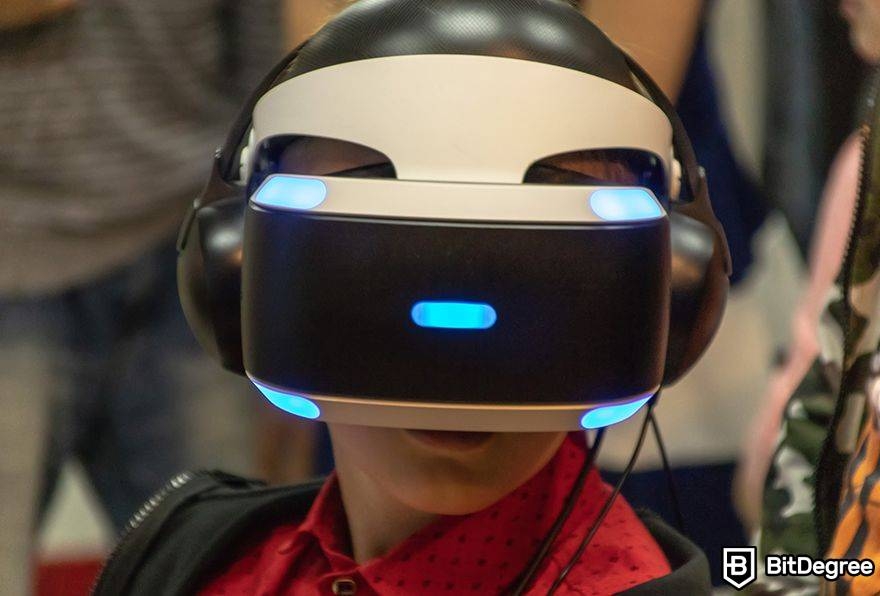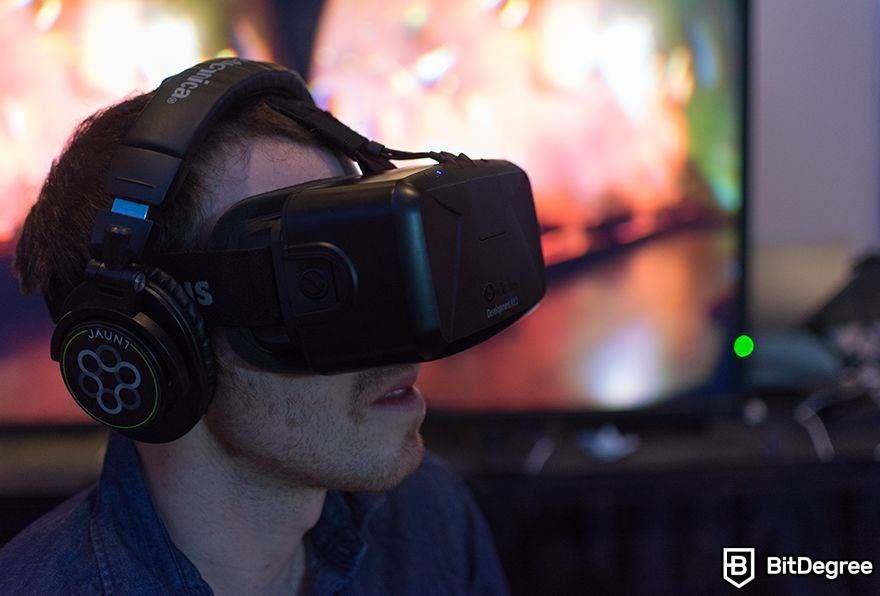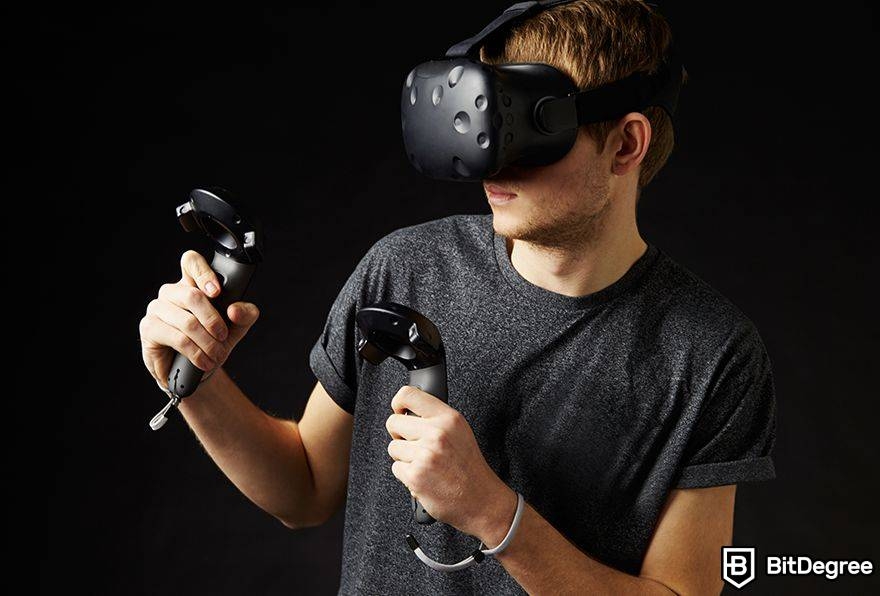Stop overpaying - start transferring money with Ogvio. Sign up, invite friends & grab Rewards now! 🎁
The metaverse is a complex term to get your head around. Despite it existing as a term for decades, it is only in the early 2020s that it gained prominence in the public eye. Along with it, has come a range of ideas that connect directly to it, such as interoperability in the metaverse.
The creation and construction of these digital worlds have sparked a desire for an interoperable metaverse - a shared space composed of other shared spaces. This concept is closely intertwined with the blockchain world, as interoperability has been a major focus for a variety of networks, such as Ethereum, Binance Smart Chain, and Polkadot.
For many, metaverse interoperability projects are at the heart of this tech wave and at the forefront of new developments. They have become a sign of what the future holds for us, as well as an indicator of how sociable and interconnected our digital lives could one day be. Let's explore what exactly interoperability in the metaverse means, how it can be achieved, and how it might shape people's lives.

Did you know?
Subscribe - We publish new crypto explainer videos every week!
What is Decentralized Crypto Gambling? (Animated Explainer)


Table of Contents
What is Interoperability?
Before we delve into interoperability in the metaverse, let's first explain what interoperability means in itself. This term is frequently used in the blockchain world, although it isn't quite catchy enough to be considered a buzzword. For this reason, it often flies under the radar for newcomers and novices in this industry.
Interoperability simply implies connectivity. It is the act of two or more entities being able to share information and utilize it practically. In the context of blockchain technology, this could also mean that assets can be transferred from one blockchain to another, or that wallets and addresses can function on different digital architectures. A common example of this is Ethereum and Binance Smart Chain.
The Binance Smart Chain is designed to be Ethereum-compatible, meaning it has interoperable features. BSC tokens can function within the Ethereum ecosystem, creating an interconnected experience. This interoperability can extend to allow the intermingling of communities belonging to both blockchains. Sometimes, interoperability is also used to refer to the sharing of groups and resources that individuals in these spaces use.

While the use of the term in this way was somewhat rare in the past, when it comes to interoperability in the metaverse, the sharing and interconnectivity between communities become much more relevant and important. In this sense, you could view the term as fairly open-ended, despite it sounding highly technical. It essentially signifies larger-scale relationships.
What is Interoperability in the Metaverse?
I alluded to this a moment ago, but interoperability in the metaverse is a much more expansive and dynamic concept than it is simply in the blockchain world. An interoperable metaverse has the same features as an interoperable blockchain, in that there is a sharing of information that can be utilized by more than one metaverse project. However, it is much more than that. There is a much greater community aspect to it.
When people talk about interoperable metaverses, they are discussing virtual spaces where assets, avatars, and other types of data can transition from one space to another seamlessly. They are discussing the movement of content and of people from one environment to another, with there being zero (or at least minimal) struggle when it comes to migrating or reintegrating.

This might sound unusual, but for many, interoperability in the metaverse is one of the primary concepts that is needed to distinguish the metaverse from a simple open-world online gaming environment. In the gaming sector, there is very little discourse or push to create programs where people can transport their assets and resources elsewhere, such as to another game.
Generally speaking, it is highly unusual for a developer to create a method that allows for the movement of any type of resource to another place. Some of this hesitation could be rooted in the fear that people would simply migrate to a more attractive location, taking their avatar, custom skins, useful objects, and even their stats elsewhere. Therefore, it doesn't seem to be in the best interest of the companies involved to offer this utility.
As a result, games, despite many being open-world and having the characteristics of a shared space, end up being closed-off realms that offer little freedom of movement. Theoretically, a metaverse project could do the same; however, many blockchain and Web3 enthusiasts view this negatively and work hard to advocate for an alternative. They want to transport the assets they own and that are important to them to another space– or at least they want the choice to do so.

This imbues the idea of interoperability in the metaverse with a more salient and direct meaning. It's not just about information being moved and shared, it's about people and their belongings becoming transportable. Part of the reason this is such a significant topic is because blockchains have already proven that something like this is possible, and so if a metaverse were blockchain-based, then it should be able to do so as well.
Additionally, blockchain-based metaverses would also have NFT capabilities, which means that people can have complete ownership over certain items or elements within these metaverses. One of the primary features of ownership (in any setting, not just digital) is that your possessions are controllable by you. If you own something, then it is meant to be under your command. For this reason, many blockchain-based metaverse enthusiasts are heavily invested in having the option to take their NFTs and move them.
Delving into Ownership
Here, you can see that ownership plays a significant role in the discourse around interoperability in the metaverse. There is a desire, so strong it almost feels like a right, for people to take the things they own and do with them as they wish. In a virtual setting, that means moving them to another digital space, should they so decide to do. For a blockchain-based metaverse, this is a significant talking point.

It is now becoming clear that interoperability in the metaverse is tied heavily to autonomy and personal freedoms. People want the choice to take what belongs to them and migrate it, along with themselves, to a different location. It's fascinating that the games of the current day, and especially of the past, that had a social and potentially immersive side to them, may have fanned the flames of this desire through their own prohibition of it.
To understand why this might have led to a greater push for an interoperable metaverse, it helps to think about how open-world and social-heavy games typically function. Players enter the world and are often given a small handful of tools or items, either cosmetic or functional in the game. They are then offered ways of gaining more of these, with greater rarity, aesthetic features, and utilities.
These can arise in the form of loot boxes, which are gambling-style mechanisms where players purchase a box or package for a chance to receive rare items, or through completing in-game quests and achievements. They can also arise via the completion of certain tasks or by foraging in the world. Additionally, items and cosmetics can be bought with either in-game currency or real-world money.

Regardless of how they are obtained, they often help to make a player’s world more exciting, and their own experience more personalized and specific. The items they have may not be the same as their peers, and the way they gained them may have special significance (even if that significance is merely because they spent money on it). While none of this is problematic in and of itself, the real issues arise when you consider the fact that most games do not let users take their goods and move them somewhere else.
If a player is interested in another game that is open-world and has a social element to it, they often have to consider whether it is worth investing their time and money into that new world, when they have already invested so much in the one they currently reside in. It can be frustrating to have to weigh up such options, especially when gaming is meant to be a fun pastime where concerns and worries are mitigated or even expelled from the mind.
In the past, the gaming world functioned fine like this, from an economic standpoint, because it was generally accepted by the gaming community that developers would never bother to make their items transportable. Not only did it not serve the developer’s best interest, as it would allow users to move to rival games, but the process of working with rival developer teams would be a headache. That level of collaboration is rare to see.

However, once blockchains came into being, and NFTs were created, it became a more tangible and relevant point to discuss. Blockchains proved they could be interconnected, and NFTs were shown to have the capacity to move from one network to another. So, with that in mind, it left the question of why exactly digital items could not be treated the same.
That question is at the crux of interoperability in the metaverse. The transportation of items has become a major topic because it has been shown to be possible. And interoperable networks show that some developers are ready and willing to connect with other networks. Better still, it is even a desirable feature that many people desperately want. The gaming world’s reluctance to try has left people with a huge appetite for this.
What this means is that, for people who spend a long time in one metaverse project, and collect a large cache of items or objects, they are now able to take those objects elsewhere, as long as they are NFTs, and they are within an interoperable metaverse. This is why it is so important that there are technological standards and codes that are followed when creating networks and assets.

The most important, and relevant, of which is that NFTs are created in a certain uniform way, so that they can be transported. For the Ethereum network, this is referred to as ERC-721, which is the standard that sets a digital asset into a standalone piece of code. If other blockchains follow this standard, then it means those assets can be transported over to that chain in a relatively seamless way. This is why Binance Smart Chain, among others, adheres to it. This is necessary for there to be interoperability in the metaverse.
Freedom of Movement
The autonomy to control assets is one reason to advocate for interoperability in the metaverse, but it is only one part of the broader discussion. Another reason is to ensure genuine freedom of movement for users between different spaces. As the metaverse is an immersive virtual location (or collection of locations), it's reasonable that people would have a lot of interest in visiting different places, even ones outside the realm or network itself.
While nothing is stopping anyone from doing this in non-interoperable metaverse projects, the act of doing so would likely mean creating a whole new avatar and leaving behind all assets. This might be acceptable for those merely curious about different spaces, but bear in mind, the metaverse is not just a gimmick. It's more an extension of the current world we live in.

So, just as people go on holiday to different countries, bringing their own clothes and possessions, it's reasonable to say that many will want to visit different interoperable metaverse projects with some of their own possessions. Not only that, but they are likely to want a relatively consistent avatar for recognizability, or at least to maintain a familiar self-image within the metaverse.
Delving deeper into the concept of freedom of movement in the metaverse, it's important to understand the psychological impact of this capability. Human identity and self-perception are intricately tied to continuity and consistency. We maintain a consistent identity throughout various physical spaces in our lives — be it our homes, workplaces, social gatherings, or even different countries. This concept of a continuous self is something that many users will expect and desire to extend into the metaverse.
Freedom of movement, where there's no need to start over with a unique avatar and set of items each time, is an essential aspect of interoperability in the metaverse. People don't want to start from scratch; they want connectivity that allows them to visit other places and interact with others in different networks, while still having access to their belongings.

This may seem trivial now, as the metaverse is still in its infancy, and many people have yet to join. However, in the not-so-distant future, where logging onto the metaverse might be a routine activity, this will become tremendously important. For instance, consider a situation where you're attending a job interview in the metaverse, but your potential employer uses a different metaverse project from you.
You'll want to present yourself professionally, which means needing digitally wearable NFTs. You might also want to bring documents or other resources to demonstrate your skills. If either of you is using a non-interoperable metaverse project, then you'd need to enter the space, source a new outfit, and, unfortunately, find another way to showcase your resources, if that's even possible. It creates a rift and sets up a frustrating scenario for both parties.
How to Achieve Interoperability in the Metaverse
Achieving interoperability in the metaverse requires a two-pronged approach. One prong focuses on the technological necessities, and the other on the business and social necessities. Let's examine the technological aspect first, as it will help illuminate the latter.

To begin with, the technology for an interoperable metaverse must exist. In the past, this might have been a considerable challenge, but advancements in the blockchain sector have made this a far more achievable scenario. It is now entirely possible for two or more decentralized networks to connect with each other and share data that can be used by all. Chains can be designed to have similar architectures, as Polygon and Ethereum do, enabling the transfer of assets.
This is one factor that makes Unstoppable Domains essential in this space, as they can offer blockchain domains that work across multiple networks. If a group of developers were considering building an interoperable metaverse, they might want to determine which ecosystem would best suit them, as the networks that make up an ecosystem are often highly interoperable. Ethereum is a solid choice, given its size, name recognition, and large developer base.
Polkadot would also be a good option, as its developers prioritized interoperability from the outset and have thus put significant thought into managing such interactions. These two ecosystems are often discussed regarding interoperability, but it's not just an either/or situation. While ecosystems interconnect best within their own network, there are also ways for networks from other architectural backgrounds to integrate.

Developers are striving to create tools and infrastructures that allow diverse and unique blockchains to work together. Some of this is still in the early stages, but there have been significant advancements in the last two years. Once this becomes commonplace, and blockchains can implement this level of uniformity regardless of their structure, interoperability will become even more expansive.
Turning to the second prong, a successful interoperable metaverse requires a business-driven desire or, at the very least, a financially motivated interest. This is because projects of this scale demand a lot of work and, consequently, a workforce motivated by such a prospect. It begins at the top, meaning business developers and founders who are attracted to the idea are necessary.
Next, a way to incentivize workers to build on it is required. The simplest option might be to create tokens specific to the metaverse project in question, which could increase in value if the project succeeds. This is the approach some interoperable metaverse projects take, with their tokens serving either as in-world currency or functioning as a type of governance token.

In traditional blockchains, governance tokens are often seen as a lazy way of adding value to an asset, as many people are uninterested in voting on the actions of a project (especially if it is a small one, or one that solves a relatively basic or trivial problem). However, a metaverse governance token would differ– here, governance would mean having the power to influence guidelines and potential metaverse laws. It's self-evident just how powerful that can be.
If people can be persuaded that this is lucrative and worthwhile, they could create an interoperable metaverse that offers financial incentives for them, along with enormous social benefits for the project's users and inhabitants. It would be a win-win situation for everyone.
Open Metaverse Interoperability Group
In the rapidly evolving digital universe, certain metaverses already exist that are interoperable. These are forerunners in a new wave of digital interaction and form an intriguing start to what is yet to come. With the rise of Web3 technologies and an increasing number of centralized companies actively exploring this field, the need and demand for more interoperable metaverses are extremely significant.

While the objectives of these centralized companies could potentially align with the open-source ethos, their historical track record of closed and non-interoperable systems casts a concerning shadow over future developments. There's a lingering apprehension among digital enthusiasts about whether these companies will continue to adhere to their traditional closed-off practices, thereby stifling the potential for a truly interconnected virtual universe.
To counteract such possibilities and foster an open, inclusive digital landscape, the Open Metaverse Interoperability Group was formed. This open-source community acts as a bastion of immersive digital standards, championing the cause of interconnectivity. Viewed through a particular lens, one could consider them a pressure group of sorts, pushing the boundaries of what's possible and challenging the status quo.
However, their mission transcends conventional activism. Comprised of developers, industry professionals, and creators, the Open Metaverse Interoperability Group doesn't just advocate for a specific future; they actively work to construct it, making strides to manifest the future they envision.

The group is dedicated to offering freedom of choice and enhancing accessibility in the virtual world, opening these digital spaces up for everybody. However, this is merely the tip of the iceberg for them. Their vision encapsulates a broad spectrum of pressing areas related to the metaverse. They are heavily invested in privacy protection, the promotion and incentivization of innovation, and the consideration of both cultural and ecological sustainability.
Such groups play a pivotal role in the metaverse's evolution, as they shape its development from a passionately ideological standpoint. They are laser-focused on the humanitarian implications of the metaverse, making sure it is guided by ethical practices and structures.
Of course, as their name suggests, interoperability is their primary aim, forming the backbone of their mission, so all their ideas and desires lead back to this. However, their work extends far beyond this primary objective. Their endeavors seep into various other goals, all interconnected with interoperability. Whether directly or tangentially, everything ties back to their central ethos of creating an interconnected metaverse, setting the groundwork for harmoniously interoperable digital realms.
Conclusions
Interoperability in the metaverse isn't merely a captivating concept; it's an integral part of the digital future we're rapidly moving towards. As the field gains momentum and becomes more sophisticated, the need for metaverse projects that can interconnect becomes increasingly important. With users craving the ability to move and transport their digital assets, including their avatars, seamlessly from one digital space to another, interoperability emerges as a key driver in the metaverse evolution.
Looking at the broader picture, if the metaverse is intended to function as an extension of our current world, it is logical to desire the ability to carry our possessions as we cross through these new landscapes. This mirrors our physical world experiences, bringing a sense of continuity and familiarity to this innovative digital space.
Historically, people have been fascinated with virtual worlds. Yet, these spaces, particularly in the early days of the online gaming industry, have been largely segregated. This isolation often led to frustration and limitations, causing a major desire for more freedom and autonomy. Today, as blockchain technology advances, the dream of a seamlessly interconnected digital environment is closer to becoming a reality.
In an inspiring demonstration of technological harmony, blockchains like Ethereum, Polygon, and Binance Smart Chain can function together and share resources, a feature that is also expected of blockchain-based metaverses. This interconnected potential is one of the key aspects that the Open Metaverse Interoperability Group is fervently advocating for. In their vision, and that of many supporters, interoperability in the metaverse isn't just a desirable feature – it's a necessary element of our digital future, an integral part that must be present as we navigate forward in this exciting field.
The content published on this website is not aimed to give any kind of financial, investment, trading, or any other form of advice. BitDegree.org does not endorse or suggest you to buy, sell or hold any kind of cryptocurrency. Before making financial investment decisions, do consult your financial advisor.








